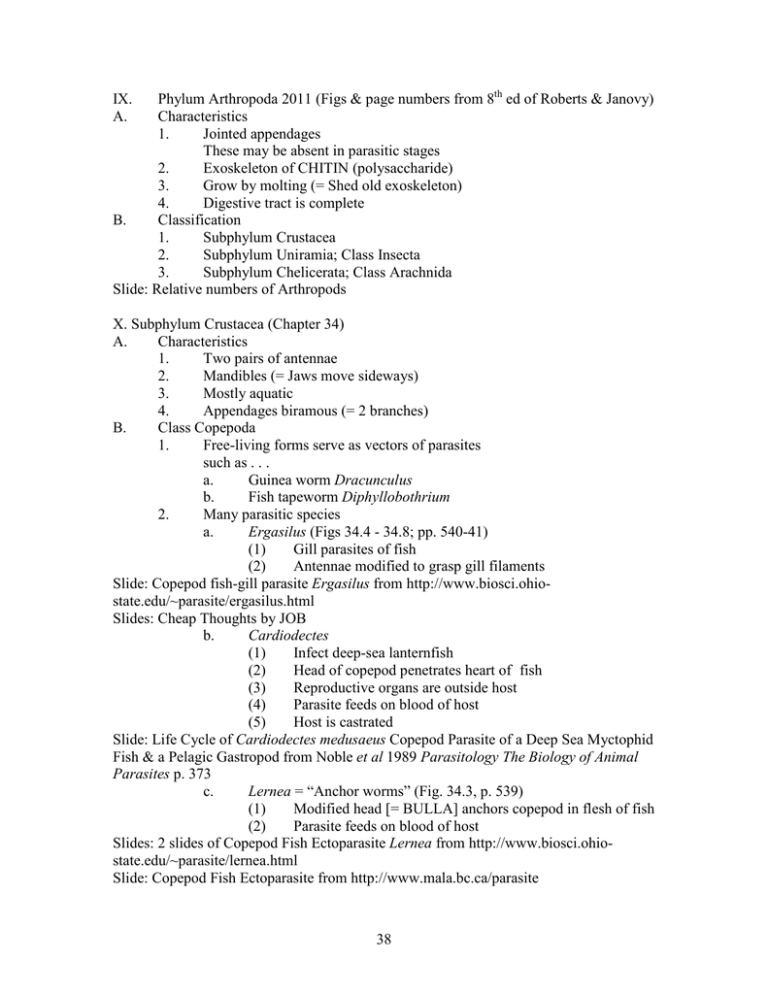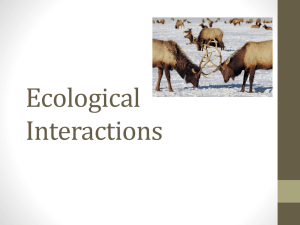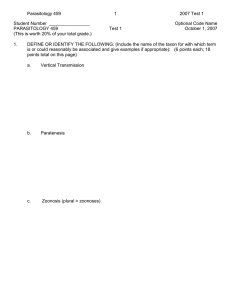IX. Phylum Arthropoda 2011 (Figs & page numbers from 8 A.
advertisement

Phylum Arthropoda 2011 (Figs & page numbers from 8th ed of Roberts & Janovy) Characteristics 1. Jointed appendages These may be absent in parasitic stages 2. Exoskeleton of CHITIN (polysaccharide) 3. Grow by molting (= Shed old exoskeleton) 4. Digestive tract is complete B. Classification 1. Subphylum Crustacea 2. Subphylum Uniramia; Class Insecta 3. Subphylum Chelicerata; Class Arachnida Slide: Relative numbers of Arthropods IX. A. X. Subphylum Crustacea (Chapter 34) A. Characteristics 1. Two pairs of antennae 2. Mandibles (= Jaws move sideways) 3. Mostly aquatic 4. Appendages biramous (= 2 branches) B. Class Copepoda 1. Free-living forms serve as vectors of parasites such as . . . a. Guinea worm Dracunculus b. Fish tapeworm Diphyllobothrium 2. Many parasitic species a. Ergasilus (Figs 34.4 - 34.8; pp. 540-41) (1) Gill parasites of fish (2) Antennae modified to grasp gill filaments Slide: Copepod fish-gill parasite Ergasilus from http://www.biosci.ohiostate.edu/~parasite/ergasilus.html Slides: Cheap Thoughts by JOB b. Cardiodectes (1) Infect deep-sea lanternfish (2) Head of copepod penetrates heart of fish (3) Reproductive organs are outside host (4) Parasite feeds on blood of host (5) Host is castrated Slide: Life Cycle of Cardiodectes medusaeus Copepod Parasite of a Deep Sea Myctophid Fish & a Pelagic Gastropod from Noble et al 1989 Parasitology The Biology of Animal Parasites p. 373 c. Lernea = “Anchor worms” (Fig. 34.3, p. 539) (1) Modified head [= BULLA] anchors copepod in flesh of fish (2) Parasite feeds on blood of host Slides: 2 slides of Copepod Fish Ectoparasite Lernea from http://www.biosci.ohiostate.edu/~parasite/lernea.html Slide: Copepod Fish Ectoparasite from http://www.mala.bc.ca/parasite 38 Slide: Copepod Shark Eye Parasite from Caloyianis, N. 1998 National Geographic, “Greenland Sharks” p. 69 C. Class Branchiura (pp 549-551, Fig 34.26) 1. “Fish lice” Argulus 2. Ectoparasites of fish 3. Large discs enable parasites to adhere to host Slide: Branchiura = Fish Louse Ectoparasite from http://www.biosci.ohiostate.edu/~parasite/argulus.htmll 4. Aquaculture controversy a. Does maintaining farm salmon in pens near rivers expose wild stock to fish lice? b. Normal life-cycle (1) Adult salmon acquire lice at sea (2) Large fish are not at risk from a few ectoparasites (3) Branchiura die when adult salmon migrate into freshwater rivers (4) Young salmon not infected Slide: Headline http://news.nationalgeographic.com/news/2006/10/061002-sea-lice.html c. New life-cycle (1) Farmed salmon are kept in large pens at mouths of rivers Slide: Farmed salmon pens (2) Farmed fish acquire lice when wild adults migrate past pens to rivers (3) Branchiura do NOT die on farm salmon in salt-water pens (4) Young wild salmon become infected when they migrate out to sea (5) Lesions caused by lice are lethal to small juvenile salmon Slides of juvenile salmon with branchiuran ectoparasites D. Class Cirripedia (= Barnacles) 1. Order Thoracica a. Typical barnacles (non-parasitic) b. Commensal species on whales (1) Predators (a) Feed only when whale moves through water (b) Not filter feeders (c) Grab shrimp, fish larvae, etc Slide: Whale Barnacle with Whale Louse from Morris, R.H. et al., 1980 Intertidal Invertebrates of California Fig 20.16 (2) Itching may cause whales to breach Slides of whales c. Octolasmis (1) Epizooite on crab gills (2) Does NOT get nutrition from crab (3) Filters food in water moving through crab gill chamber (4) Causes significant damage to crab gills 39 Slide of Octolasmis on blue crab gills 2. Order Rhizocephala Fig 34-29; pp 551-553) a. Parasitize crabs and shrimp Slide: Rhizocephalans are Classified as “Barnacles” because They Have Typical Barnacle Larvae Slide: Diagram Showing Internal Root System and External Sac of the Rhizocephalan Sacculina carcini Slide: The External Stage of a Rhizocephalan Barnacle Occupies the Region Where an Unparasitized Female Crab would Brood Her Eggs Slides of rhizocephalans infecting a hermit crab and a typical barnacle b. Effects induced by family Sacculinidae (1) Hosts are castrated (a) Reproductive organs do not mature (b) Hosts will acquire the external morphology of adult crabs (2) Male crabs become feminized (a) Females have a wide abdomen or “apron” that covers egg mass (b) Infected males will acquire an abdomen wider than that of males, but often not as wide as that of females Slide: Rhizocephalan Barnacle Parasitizing a Partially Feminized Male Host; Notice that the abdomen does not cover the external stage (3) A crab with the external stage of sacculinid will not molt (a) Barnacle will molt following release of larvae (b) Since both host and parasite are crustaceans with homologous endocrine systems, it is puzzling as to how growth is inhibited in host but occurs in parasite (4) Parasitized crabs bearing external stage are significantly smaller than unparasitized adults Slide: Size Difference Between Unparasitized Blue Crabs and Crabs Parasitized by the Rhizocephalan Loxothylacus texanus Slide: Blue Crab Infected With the Rhizocephalan, Loxothylacus texanus and a Normalsized Unparasitized Adult Female c. Aspects of the biology of the sacculinid rhizocephalan, Loxothylacus texanus (1) Parasitize swimming crabs such as the blue crab, Callinectes sapidus (2) Range of the parasite is limited to part of the range of blue crab (a). L. texanus restricted to the Gulf of Mexico and Atlantic south of South Carolina (b) Range of blue crab extends along Atlantic Coast to New England (3) Economic pest (a) Parasitized crabs do not attain legal size (b) Parasitized crabs do not reproduce (4) Factors that affect the ability of parasite larvae to infect crabs (a) Parasite larvae cannot survive in low (<12ppt) salinity water 40 (b) (c) Only small recently molted crabs are susceptible to infection Parasites produce significantly more larvae at warm temperatures than cold Slide: Effect of salinity on survival of rhizocephalan larvae Table Slide: Effect of Host Molt Stage on Infection Success of Loxothylacus texanus Slide: Effect of temperature on duration of broods (5) Summation of knowledge about infection (a) Probably occurs in high salinity waters near the mouth of estuaries (b) Small, soft-shell crabs are probably the ones infected (c) Most infections probably occur during the warmer months of spring and summer E. Order Amphipoda 1. “Hoppers” 2. Bodies are flattened laterally 3. Serve as intermediate hosts for acanthocephalans 4. Family Cyamidae (Fig 34.32, p. 555) a. Whale lice b. Feed on dead skin, mucus, and epithelial tissue around whale barnacles 5. One of the few crustacean parasites that does not swim, requires physical contact to reach new host a. Nursing calf b. Sexual intercourse Slide: Amphipod Whale Ectoparasite F. Order Isopoda (pp 555-557) 1. Same order as terrestrial pillbug or rolly-polly 2. Body is flattened dorsal-ventrally 3. Suborder Epicaridea (pp 556-557) a. Parasitic castrators of crustaceans b. Sex determination (1) First parasite to arrive becomes female (2) Second parasite attaches to female and becomes male c. Family Bopyridae (1) Gill parasites of shrimp and crabs (2) Infected hosts recognized by swollen gill chamber (3) Feed on blood of host Slide: Bopyrid Shrimp Gill Parasite from http://www.louisiana.edu/Departments/BIOL Slides: Collecting mudshrimp in Oregon; Mudshrimp with bopyrid in gill chamber & bopyrid removed; 3. Suborder Epicaridea (continued) d. Family Entoniscidae (1) Most are internal parasites of crabs (2) Some are hyperparasites of rhizocephalans Slide: Entoniscid isopod in hermit crab 4. Family Cymothoidae a. Most are gill parasites of fish 41 b. Some in mouth c. Lironeca infects fish locally Slide: Cymothoid Isopod Fish Gill Parasite from http://www.mala.bc.ca/parasite Slide: Cymothoid Isopod Fish Parasite from Brusca, R.C. 1978 Crustaceana 34(2):144 Slide: Cymothoid Isopod Fish Parasite “[The isopod] invades a fish’s mouth, devours its tongue, and takes the tongue’s place. It then acts like a tongue; the fish can use it to grip and swallow prey.” From Zimmer, C. 2000 Parasite Rex G. Order Decapoda 1. Ten legs (Crabs, lobsters & shrimp) 2. Family Pinnotheridae a. Small & elongated b. Commensals (1) Oysters (some species damage hosts) (2) Worm tubes H. Subclass Pentastomida [= Tongue Worms] (Chapter 35) 1. Formerly in its own phylum, recent RNA sequence data firmly places the group within the Crustacea 2. Characterized by presence of 2 pairs of hooks on mouth region Slide: Pentastomatid Body Shapes and Characteristic Two Pairs of Hooks, Fig. 35.2, p. 562 3. Life-cycle a. Adults usually found in respiratory tracts of reptiles (1) Snakes (2) Local species in alligators b. Intermediate hosts (1) Insects (2) Fish (3) Mammals 4. Linguatula serrata a. Unusual in that adults parasitize nasopharyngeal region of canines and felines b. Mammals intermediate hosts Slide: Life-cycle of the Pentastomatid Linguatula serrata, (Fig. 35.9, p. 566) 42






